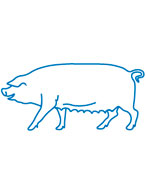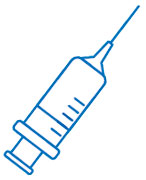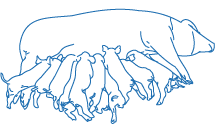Porcine parvovirus is an exclusively reproductive disease, which occurs when porcine parvovirus infects gestating sows that have no protective immunity against this infection. The infection produces no symptoms in the affected breeding sows, but the virus crosses the placental barrier and affects their progeny.
The reproductive disorders caused by this disease depend on the stage of gestation at which the infection occurs. If the embryos are infected before day 35 of gestation, embryonic mortality and resorption will occur. Between 35 and 70 days of gestation, fetal death and mummification occur. After 70 days the fetus is immunocompetent and survives the infection.

There is a wide range of commercial vaccines against this disease, the main difference being whether or not they are combined vaccines. Although, we can find some other distinctions according to the specifications in their data sheets.
Type |
|
 |
Most commercial vaccines against porcine parvovirus are based on inactivated virus. This type of vaccine is the one we will discuss in this article. In this case, all of them are administered intramuscularly. |
Target species |
|
 |
Parvovirus vaccination is administered to breeding females, gilts and sows, according to the technical data sheet. Only some commercial options specify its use in boars. |
Indications for use |
|
 |
As mentioned above, swine parvovirus is an exclusively reproductive disease. Therefore vaccines specify indications for use such as "for the active immunization of sows to protect progeny against transplacental infection caused by porcine parvovirus," "for the protection of their embryos and fetuses against porcine parvovirus infection," or similar indications. |
Dosage |
|
 |
A particularity of porcine parvovirus infection is that maternal immunity to this virus is long-lasting, so the different vaccines have indications for primovaccination such as, "Pigs from 6 months of age which have not been previously vaccinated should be given two injections with an interval of 3-4 weeks. The second injection should be administered 3-4 weeks before mating." In a specific case, the minimum age of vaccination is 5 months. As for revaccination, the recommendations are always around 2-4 weeks before the next mating. In only one case is the recommendation on the technical data sheet a complete vaccination program for the entire farm. |
Start and duration of immunity |
|
 |
Immunity occurs 3 weeks after the second dose with primovaccination, or after revaccination. The duration of immunity is specified as 5, 6 months, or throughout gestation in the different options. |
Combined vaccines |
|
 |
Some vaccines protect exclusively against porcine parvovirus, but combined vaccines are very common, especially for parvovirus and erysipelas. There is also a commercial vaccine that offers triple vaccination against parvovirus, E. rhusiopathiae (erysipelas), and some leptospira serovars. Another combines parvovirus, E. rhusiopathiae (erysipelas), and inactivated Aujeszky's vaccine.  Some vaccines can be mixed with certain live PRRS vaccines, according to the technical data sheet. |
Use in gestation and lactation |
|
 |
Although, as mentioned above, the usual recommendation is vaccinating before mating, most vaccines allow their use in both gestation and lactation. However, one of the options does not allow its use in gestation, and another specifies "avoid vaccinating 3 weeks after mating." |
Porcine parvovirus vaccination is widely used in the swine industry and when executed properly protects against the described reproductive problems.
333 Staff



